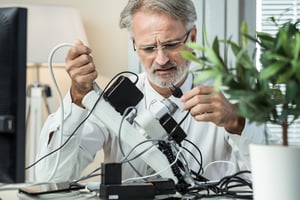 Power strips and surge protectors are a necessity in many homes today. With smartphones, tablets, streaming media devices, and gaming consoles, we have a lot of toys to plug in. Don’t forget about TVs, lamps, and other household items. All these items plugged into a power strip can put stress on it.
Power strips and surge protectors are a necessity in many homes today. With smartphones, tablets, streaming media devices, and gaming consoles, we have a lot of toys to plug in. Don’t forget about TVs, lamps, and other household items. All these items plugged into a power strip can put stress on it.
Most people probably don’t give much thought to how many devices are plugged in at any given time. Did you know that approximately 4,600 home fires start as a result of extension cord and power strip overuse each year? These fires account for 70 deaths and 230 injuries.
Before I share some safety tips, I’d like to explain the difference between each. While this may seem like common sense, it’s important to understand they’re slightly different.
Have you ever gone to the store wanting to buy a surge protector and when you got home your realized you bought a simple power strip? This happened to me with the mass confusion while trying to set up my daughter’s dorm room.
A power strip and surge protector power strip look pretty much the same. They’re both skinny, rectangular, plastic boxes with multiple outlets for you to plug in multiple devices. However, surge protectors:
- May be a bit more expensive;
- May have additional lights near the power button which light up when plugged in; and
- Contain internal components which can prevent spikes and surges in power from destroying your devices.
If ordering online or buying at your local hardware store, always read the product description to make sure you’re buying the right one. Personally, I’d recommend buying a surge protector for all your household needs. This way you’re not left guessing if your devices, TVs, computers, etc. are protected.
One common misconception that I had is that surge protectors provide protection against lightning strikes. I’ve learned lightning strikes are simply too powerful. Surge protectors provide protection from current fluctuations that travel down your power line.
Here are some things you can do to keep your home and family safe.
- Never use power strips or surge protectors for high-power capacity items such as, space heaters, dehumidifiers, or other high capacity appliances. Plug them directly into a wall outlet.
- Don’t connect multiple power strips together to increase the number of outlets available. However, you can temporarily plug an extension cord into a power strip.
- If you’re using power strips or extension cords in multiple places in your home, consider hiring an electrician to install more outlets. This is a safer alternative because the wires in your wall are of higher quality. Multiple extension cords or power strips was always my dad’s pet peeve back in the day when he was an electrician.
- Never use power strips or extension cords in a bathroom or on the kitchen counter top.
- Do the math. Try to determine what the power strip can handle by looking at its specifications on the package. The most important number is watts. The higher the number, the better. Add up the number of watts used by the devices you’re plugging in. This number should not exceed the total number of watts specified on the package. If buying a surge protector, look at the suppressed voltage rating as well. A lower number will provide better protection against surges. If you’re like me and don’t like math, talk to someone at the store that understands them.
- Don’t just look at price. Make sure you’re buying the correct one for your household needs and that it’s certified.
- Never try to prevent trip and fall hazards by covering cords up with a rug. Repeatedly stepping on them can cause cords to breakdown, which could lead to a fire.
Here are some ways to prevent or tell if your power strip is overloaded.
- Surge protectors are great because they provide several outlets. However, depending on what you’re plugging in, not everyone should be used. Most things we plug in such as a phone, computer, or gaming console don’t use much power. Items found in your kitchen such as a toaster, crockpot, or skillet would draw more power and could potentially cause issues.
- If the power strip or surge protectors feels hot, this is a good sign that you have too many things plugged in.
- Watch for burn marks or melted plastic.
Before plugging in your next electronic device, look at what’s going on with your power strip or surge protector.
Sources:
https://www.cpsc.gov/content/limit-extension-cords-to-reduce-risk-of-fire
https://www.safebee.com/home/guide-power-strips-and-surge-protectors
SOURCE: West Bend, Scott Stueber on Mar 12, 2019 9:00:00 AM
Leave a Reply